The New York State Department of Health (NYSDOH) has confirmed the first locally acquired case of chikungunya on Long Island – marking the first such case ever reported in New York and the first in the United States since 2019, according to ABC News.
Health officials said laboratory tests at the department’s Wadsworth Center confirmed the infection in a resident of Nassau County. An investigation suggests the individual was likely bitten by an infected mosquito, though the exact source of exposure remains uncertain. According to the officials, the precise source of exposure is not known since the case is classified as locally acquired based on current information.
Chikungunya syptoms
Chikungunya is a mosquito-borne viral disease commonly found in tropical and subtropical regions. Symptoms include sudden fever, joint pain, headache, muscle pain, swelling, and rash. Although the illness is rarely fatal, it can cause prolonged joint pain in some patients. Most people recover within a week.
Risk remains low amid cooler temperatures
The virus spreads through bites from infected mosquitoes, primarily Aedes albopictus, which are found in parts of downstate New York. Local transmission can occur if a mosquito bites an infected traveler and then bites another person, according to the NYSDOH.
State Health Commissioner Dr. James McDonald said that the Wadsworth Center has confirmed this test result, which is the first known case of locally acquired Chikungunya in New York State. “Given the much colder nighttime temperatures, the current risk in New York is very low,” said the Commissioner.
Authorities added that three other chikungunya cases detected in 2025 outside New York City were linked to international travel. Routine mosquito testing by the NYSDOH and the New York City Department of Health and Mental Hygiene has not found any evidence of the virus in local mosquito samples.
Officials advised residents to prevent mosquito bites by using EPA-approved repellents, wearing long sleeves and pants, clearing standing water near homes, and repairing window screens.
